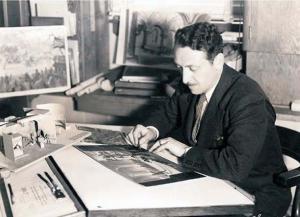
Anton Grot Net Worth is
 $1.7 Million
$1.7 Million
Mini Biography

Anton Grot was profoundly influenced by Western modernism and expressionist artwork in both film and painting by enough time he still left Poland for america in 1909. Having examined illustration and style at Cracow and Koenigsberg, majoring in interior adornment, he was quick to embrace the burgeoning artwork deco motion and the reduced key, stylised style widespread in early German movie theater. His initial film function was with Lubin in Philadelphia, as established painter and developer in 1913. He continued to be in the East Coastline until 1922, and was after that employed by Douglas Fairbanks and Cecil B. DeMille to focus on the visible Fairbanks swashbuckler Robin Hood (1922). Through the following five years, Grot set up his qualifications at United Performers, departing in 1927 to become listed on First Country wide. When that firm was ingested into Warner Brothers, Grot was appointed Mind of the Artwork Department and kept that placement until his pension in 1948. His first main assignment was the biblical devastation epic Noah’s Ark (1928) that Grot designed the place for massive Temple of Moloch and created the all-consuming torrent on the climax. This is the to begin sixteen collaborations with best Warner’s movie director Michael Curtiz. Grot excelled at creating the prevailing feeling of the film, often improving the work from the cinematographer. Stage in the event, Svengali (1931) – using its stylised, expressionist-inspired Parisian structures and labyrinthine roads – that both he and Barney McGill garnered Oscar nominations. After ‘Svengali’, Grot was nearly exclusively responsible for the studio’s prestige result, including Captain Bloodstream (1935), Anthony Undesirable (1936) and THE LIFE SPAN of Emile Zola (1937). He was at his greatest, developing a sinister or foreboding atmosphere through sharply angled shadows, dramatic light and clever usage of chiaroscuro. His many complete and highly achieved sketches for his units are actually housed in the UCLA library. While his function contributed towards the gritty, realistic look typical of Warner Brothers motion pictures during this time period, Grot was adaptable plenty of to take care of glamorous subjects and musicals (Gold Diggers of 1933 (1933), Romance within the High Seas (1948)) with equal aplomb. A few of his most amazing sets involved drinking water, or, rather, prodigious levels of drinking water. For the studio-bound Errol Flynn swashbuckler THE OCEAN Hawk (1940), he produced a 12 feet. deep lake on a whole new sound stage, which added greatly to the entire $1.7 million budget (as do both full-scale cruising vessels utilized for the fight scenes). Grot consequently won a particular Academy Award for his creation of the ‘ripple machine’ which simulated climate effects on drinking water. No less amazing had been his interior units, notably the magnificent giant map in the Spanish courtroom which the downfall of Britain is plotted, as well as the vast along stairwells which provide as the setting for the climactic duel between Flynn’s Geoffrey Thorpe and arch villain Lord Wolfingham (Henry Daniell). After his retirement, Grot devoted a lot of his time for you to painting. He passed away in March 1974 at age 90 and was inducted in to the Artwork Directors Hall of Popularity in 2004.
Known for movies




